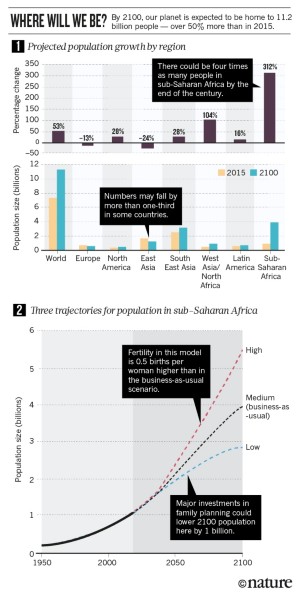33 What Did the Continued Population Growth in the Colonies Intensify
Within a decade, women everywhere should have access to quality contraceptive services, argues John Bongaarts.

Oshodi market in Lagos. Credit: George Osodi/Panos
In 2100, our planet is expected to be home to 11.2 billion people. That's a more than 50% increase on today's 7.3 billion1. This expansion of humanity is likely to be spread unevenly across the world. In the most developed regions, we expect declines (such as in Europe and east Asia) or little further growth (as in the Americas; see 'Bulges, gaps and shifts'). Substantial further growth is anticipated in the least developed regions of south and west Asia (including in India and Pakistan) and north Africa (for example, in Egypt). By far the largest increase is projected in sub-Saharan Africa with a quadrupling of population — from just shy of 1 billion currently to 3.9 billion.
This potential addition of 4 billion people to the poorest regions of the globe is an obstacle to development that makes it difficult to be optimistic about their futures. Rapid population growth, with attendant consumption and waste, has pervasive adverse effects on societies and the world's ecosystems (see 'Four ways population rise takes its toll'). Many countries would be better off with lower population growth and birth rates. This is exemplified by the east Asian 'tiger' economies, including South Korea and Taiwan, that in recent decades have seen rapid increases in per capita incomes as birth rates declined. The boost to economic growth that follows a decline in fertility is referred to as the 'demographic dividend'2.
So, how can the population juggernaut be stopped, or at least slowed?
What can be done
Since the 1960s, the main policy response to rapid population growth, alongside investments to improve education and health, has been the implementation of voluntary family-planning programmes3. To make contraception accessible, these programmes train staff, subsidize costs and develop distribution schemes — for example, clinics, drug stores and other delivery systems. Equally important, they provide education about the health and the socio-economic benefits of using contraception and having smaller families. The key reason for these programmes is to address the substantial level of unwanted and unplanned pregnancy, as well as an unsatisfied demand for contraception. About 74 million unplanned pregnancies occur each year in the developing world (39% of annual developing-world pregnancies). About half of these end in induced abortions4.

Among the reasons for unwanted and unplanned pregnancies are low levels of female education, a lack of knowledge about and access to contraception, insufficient supplies and services, cost and fear of side effects. Just as problematic are opposition from spouses and other family members and traditional gender roles that support a desire for large families. To reduce unintended pregnancies, family-planning programmes must go beyond simply providing supplies and services; they must also reduce or eliminate these other obstacles.
The most persuasive evidence that such programmes work comes from field experiments, such as the one that began in 1977 in the Matlab region of Bangladesh5. A control area of Matlab received the same limited family-planning services as the rest of the country. An experimental area was provided with free services and supplies, home visits by well-trained female family-planning workers, and comprehensive media communication. Outreach to husbands, village leaders and religious leaders addressed potential social and familial objections.
The results were clear-cut. Contraceptive use jumped from 5% to 33% among married women of reproductive age in the experimental area. In the control area, little changed. As a result, fertility declined rapidly in the experimental area. A difference of about 1.5 births per woman between the experimental and control areas was observed until 1990, and a smaller difference continued beyond 1996, when the experiment ended. Among the long-term consequences of this difference were the children in the experimental area being educated to higher levels, families having greater household assets, and the greater use of preventive health services. The experiment demonstrated that family-planning programmes can succeed even in highly traditional societies.
Contemporary evidence is fully consistent with the Matlab record. For example, countries that have suddenly implemented comprehensive family-planning programmes (such as Iran in 1989 and Rwanda in the mid-2000s) have seen rapid subsequent changes in reproductive behaviour.
Iran's fertility declined at an extraordinary pace from 5.6 births per woman in the late 1980s to 2.6 a decade later6. In Rwanda, fertility dropped from 6.1 in 2005 to 4.6 in 2010, and the proportion of married women using contraception jumped from 17% to 52%7. Both countries' information programmes shifted norms by including messages about the benefits of smaller families, raising the demand for family-planning services.
Any acceleration of fertility decline changes the trajectory of future population growth. This impact can be large, as demonstrated by a comparison of alternative United Nations population projections1 for sub-Saharan Africa. With major investments in family planning, the fertility trajectory could easily be reduced by 0.5 births per woman within a few years after the start of the intervention. This would lead to a population of 2.8 billion in sub-Saharan Africa by 2100 (see 'Where will we be?'). That is around 1 billion fewer people than in the business-as-usual projection.

Credit: Source: Ref. 1
Family-planning programmes are most effective where socio-economic conditions are improving. In particular, education of girls is a powerful brake on fertility. Educated women marry later, tend to want smaller families (in part, because the opportunity costs of childbearing are higher for these women) and are more capable of overcoming obstacles to their use of family planning. However, educated women must have access to contraception to act on their reproductive preferences. Family planning, education (of women and men) and socio-economic development are mutually reinforcing, and should be pursued together.
Evolution of support
Family-planning programmes have been controversial, and support for them has fluctuated widely over the past half-century3. An initial surge of investment was made in the 1960s and early 1970s, as the UN and donor countries urged developing countries to address high fertility and rapid population growth. Several such countries accused the industrialized nations of making neo-colonial and imperialistic efforts to keep them weak and impoverished.
The Catholic Church, long opposed to artificial birth control and abortion, took an increasingly aggressive stance in opposition to government-sponsored family planning programmes worldwide. And when Republicans have occupied the White House, US lawmakers have also generally been unsupportive of international family-planning programmes — reducing funding and adding onerous restrictions.
Nonetheless, contraceptive use rose steadily in Asia and Latin America during the 1980s (see go.nature.com/r2oqrl). Then, in the 1990s, aid for family planning was diverted to fight the AIDS epidemic in Africa and elsewhere. Moreover, the fertility declines in Asia and Latin America led to optimism that population growth in Africa would soon slow.
Political and religious opponents were able to draw support for their views from a disagreement stirring in the academic literature: some economists argued that voluntary family-planning programmes are ineffective8. Conventional economic theory considers parents as people who want to maximize utility, and, who — within their budget — choose the number of children that they have in the same way that they might choose how many televisions or bicycles to buy.
In particular, education of girls is a powerful brake on fertility.
An obvious problem with this reasoning is that durable goods require an active purchase, whereas pregnancies occur unless an effort is made to avoid them. Furthermore, economic theories also typically assume that the cost (monetary, social and practical) of contraception is sufficiently low so as not to influence decision-making. From this academic perspective, the occurrence of unwanted pregnancies should be as rare as people having unwanted new televisions; thus family-planning schemes should not be given priority.
Needless to say, that is not how things work in the real world. Avoiding unintended pregnancies is difficult even for women who use relatively effective methods and as a result, tens of millions of such pregnancies occur each year. Happily, the accumulating evidence of plummeting birth rates in a few countries (such as Ethiopia and Rwanda) has now largely persuaded policymakers of the cost-effectiveness of these programmes9. Religious and political opposition persists.
What now?
To reduce rapid population growth and high birth rates, it is essential to start with a clear objective: within a decade, women everywhere should have access to quality contraceptive services. Even in rural areas of poor countries, women should have the choice of multiple contraceptive methods — including not only pills, injectables and barrier methods, but also long-acting methods such as intrauterine devices and systems (IUDs and IUSs), implants and sterilization. Where legal, safe abortion services should be made available. Other obstacles to contraceptive use, such as incorrect rumours about side effects and conservative social attitudes, should be addressed by the education of women and men, media campaigns and collaboration with community leaders.
These efforts can be led by governments but better results are obtained when services are distributed through multiple channels, including private commercial providers and non-governmental organizations. Importantly, coercion of any kind should be ruled out. Women and men have the right to decide freely on the number, timing and spacing of children, and on the means to achieve their reproductive goals.
Importantly, coercion of any kind should be ruled out.
Achieving these aims requires substantially more resources than are available now. Funds are needed to build and equip clinics, to train and pay providers and to subsidize the direct cost of methods and services that are out of the reach of too many poor people. Over the past decade, investments in the developing world have risen, especially after the 2012 London Summit on Family Planning, at which many donors and governments renewed or increased their commitments.
Still, only 1% of all overseas development assistance (ODA) is now allocated to family planning10. This amount is inadequate; in too many countries, programmes remain weak and political commitment is lacking.
The proportion of ODA allocated to family planning should be raised to 2% and developing-countries governments should expand their funding by an equivalent proportion. Such a doubling of funding will be more than repaid by savings in other sectors such as education and health care in future years.
From the top
The final, crucial ingredient for success is political will and a commitment to family planning at the highest levels of national and international policymaking. A fundamental reason for the low priority assigned to the issue is that it is considered a health and human-rights problem.
Hence, family planning is part of the health budgets of donors and the responsibility for family-planning programmes is assigned to ministers of health throughout the developing world. Most poor countries are battling a range of diseases, and family planning is often not seen as a high health priority. From a broader development perspective, the low priority is nonsensical.
Several actions would remedy this situation. At the international level, development agencies and donors should hire more population experts (the World Bank, for example, employs thousands of economists but only a few demographers). These organizations write hundreds of reports on every dimension of development, yet only a fraction comment on population trends. Such reports should include a discussion of the role of demographic shifts in relevant sectors, of the development benefits of reduced birth rates and of the options available to change these trends.
At the national level, similar changes are needed. Typically, population trends are noted in government plans but are considered immutable and therefore of little interest. Ministries of finance or planning commissions often make detailed projections for specific sectors but rarely examine alternative population trajectories. They should. Economists at the Copenhagen Consensus Center, a think tank, last year ranked family planning as one of the most cost-effective development interventions (see go.nature.com/fumoop).
Family planning must be reclassified as a development intervention (as well as being a health and human-rights intervention) to give it the high national and global priority it deserves. This would lead to a more cost-effective use of scarce development resources, and to more rapid growth in living standards in poor countries.
Source: https://www.nature.com/articles/530409a
0 Response to "33 What Did the Continued Population Growth in the Colonies Intensify"
Post a Comment